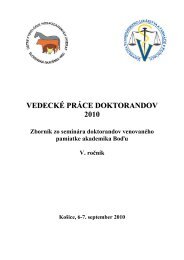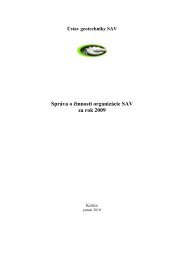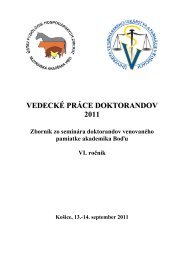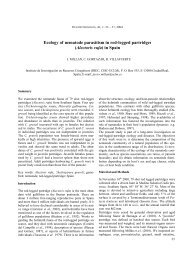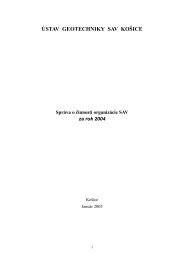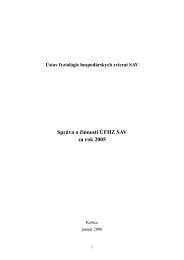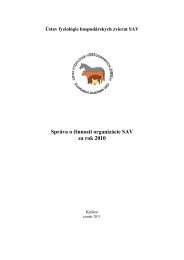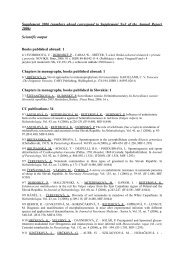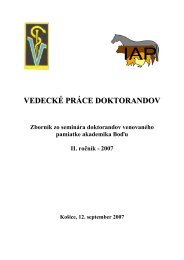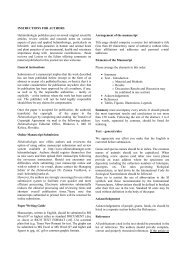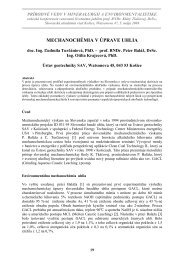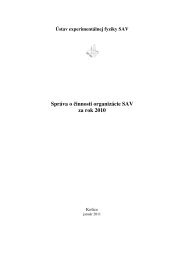Troglotrema acutum (Digenea) from carnivores in the Czech Republic
Troglotrema acutum (Digenea) from carnivores in the Czech Republic
Troglotrema acutum (Digenea) from carnivores in the Czech Republic
You also want an ePaper? Increase the reach of your titles
YUMPU automatically turns print PDFs into web optimized ePapers that Google loves.
<strong>acutum</strong> <strong>in</strong> M. putorius and some o<strong>the</strong>r <strong>carnivores</strong> lead us to<br />
predict that <strong>the</strong> range of <strong>in</strong>termediate snails is probably<br />
even wider and <strong>in</strong>cludes also some o<strong>the</strong>r species of prosobranchiate<br />
snails. Unlike <strong>the</strong> species of Byth<strong>in</strong>ella, <strong>the</strong>ir<br />
which distribution and occurrence <strong>in</strong> <strong>the</strong> <strong>Czech</strong> <strong>Republic</strong> is<br />
nei<strong>the</strong>r geographically not sea level strictly limited (Beran,<br />
1998). The <strong>in</strong>fection focuses and <strong>the</strong>ir existence <strong>in</strong> time<br />
and space, as well as <strong>the</strong> significance of <strong>the</strong> typical f<strong>in</strong>al<br />
host result <strong>from</strong> <strong>the</strong> biological relations <strong>in</strong> <strong>the</strong> food cha<strong>in</strong><br />
of <strong>the</strong> particular biocoenosis. It is known that polecats have<br />
ei<strong>the</strong>r movements only <strong>in</strong> a restricted range or more or<br />
less l<strong>in</strong>ear movements with<strong>in</strong> <strong>the</strong> home range (Lodé,<br />
1999). The capture of anurans is easy for polecats (Weber<br />
1989), and frog aggregation at spawn<strong>in</strong>g sites <strong>in</strong> spr<strong>in</strong>g<br />
(Blab, 1986; Guyétant, 1986) probably facilitates predation.<br />
Studies on polecat ecology <strong>in</strong> Europe <strong>in</strong>dicate that amphibians<br />
form a significant part of its diet throughout <strong>the</strong> year.<br />
Dur<strong>in</strong>g <strong>the</strong> vegetation season it is 17.6�� 84.8 % (V) and <strong>in</strong><br />
w<strong>in</strong>ter months still 17.6 � 40.7 % (Wolsan, 1993). In <strong>the</strong><br />
diets of o<strong>the</strong>r mustelids amphibians are represented far<br />
less, which corresponds to <strong>the</strong> prevalence of T. <strong>acutum</strong> <strong>in</strong><br />
<strong>the</strong>se species. However, if <strong>the</strong>ir home ranges overlap or encroach<br />
upon <strong>the</strong> focus of T. <strong>acutum</strong> <strong>in</strong>fection, <strong>the</strong>se species<br />
can also take part <strong>in</strong> <strong>the</strong> <strong>in</strong>fection cycle.<br />
It is possible to <strong>in</strong>terpret our results as follows: occurrence<br />
of T. <strong>acutum</strong> on <strong>the</strong> territory of <strong>the</strong> <strong>Czech</strong> <strong>Republic</strong> is only<br />
sporadic and <strong>the</strong> active <strong>in</strong>fection focuses are ma<strong>in</strong>ly <strong>in</strong> <strong>the</strong><br />
localities with lower altitude. Besides <strong>the</strong> headstream regions<br />
it can be also found at localities with prevalence of<br />
stagnant water reservoirs. Due to <strong>the</strong> high pathogenicity of<br />
T. <strong>acutum</strong> (see Olt, 1929; Baer, 1931; Dialer, 1938; Artois<br />
et al., 1982), this helm<strong>in</strong>thosis may be an important factor<br />
<strong>in</strong>fluenc<strong>in</strong>g <strong>the</strong> population density of polecat <strong>in</strong> <strong>the</strong> <strong>Czech</strong><br />
<strong>Republic</strong>. Never<strong>the</strong>less, it is not possible to confirm a direct<br />
relationship between <strong>the</strong> decrease of population density<br />
of polecat <strong>in</strong> <strong>the</strong> <strong>Czech</strong> <strong>Republic</strong> and prevalence of T.<br />
<strong>acutum</strong> <strong>in</strong>fection dur<strong>in</strong>g <strong>the</strong> last 10 years.<br />
Acknowledgement<br />
PK was founded by Grant Agency of Academy of Sciences<br />
of <strong>the</strong> <strong>Czech</strong> <strong>Republic</strong>, No. S6093003, VB was founded by<br />
Research Project No. KSK 6005114 and BK was founded<br />
by Research Project of <strong>the</strong> Masaryk University, Brno No.<br />
MSM 143-1000-10.<br />
References<br />
AND�RA, M., HANZAL, V. (1996): Atlas of <strong>the</strong> Mammals of<br />
<strong>the</strong> <strong>Czech</strong> <strong>Republic</strong> II. Carnivores (Carnivora). National<br />
Museum, Prague<br />
ANISIMOVA, E. I. (2002): Comparative analysis of <strong>the</strong> helm<strong>in</strong>thocoenoses<br />
of <strong>the</strong> otter (Lutra lutra) and polecat (Mustela<br />
putorius) <strong>in</strong> Belarus. Helm<strong>in</strong>thologia, 39: 87 – 90<br />
ARTOIS, M., BLANCOU, J., GERARD, Y. (1982): Parasitisme<br />
du putois (Mustela putorius) par <strong>Troglotrema</strong> <strong>acutum</strong>. Revue<br />
Méd. Vét., 133: 771 – 777<br />
30<br />
A�MERA, J. (1985): <strong>Troglotrema</strong> <strong>acutum</strong> – parasite of polecats.<br />
Myslivost, 83: 11<br />
A�MERA, J. (1986): Distribution of <strong>Troglotrema</strong> <strong>acutum</strong> <strong>in</strong><br />
<strong>Czech</strong> <strong>Republic</strong>. Myslivost, 84: 39<br />
BAER, J-G. (1931): Quelques Helm<strong>in</strong><strong>the</strong>s rares ou peu<br />
connus du Putois. Revue Suisse Zool., 38: 313 – 334<br />
BAER, J-G. (1932): Contribution à la faune helm<strong>in</strong>tologique<br />
de Suisse. Rev. Suisse Zool., 39: 1 – 56<br />
BERAN, L. (1998): Aquatic Molluscs of <strong>the</strong> <strong>Czech</strong> <strong>Republic</strong>.<br />
ZO �SOP Vla�im, 17: 1 – 113<br />
BLAB, J. (1986): Biologie, Ökologie und Schutz von Amphibien.<br />
Kilda Verlag, Bonn, Bad Godesberg<br />
�ERVENÝ, J., KOUBEK, P. (2000): Variability of body<br />
and skull dimensions of <strong>the</strong> lynx (Lynx lynx) <strong>in</strong> <strong>the</strong> <strong>Czech</strong><br />
<strong>Republic</strong>. Lynx (Prague), 31: 5 – 12<br />
DIALER, L. (1938): Zur Histopathologie parasitärer Knochenerkrankungen<br />
(Alveolar Ech<strong>in</strong>ococcus des Knochens<br />
und <strong>Troglotrema</strong> – Osteomyelitis). Frankf. Z. Path., 52:<br />
547 – 566<br />
DYK, V. (1960): Skull bones perforation of polecats. Myslivost,<br />
48: 62<br />
FALTÝNKOVÁ, A., LITERÁK, I., HAMAN, A. (2001): Cercarie<br />
found <strong>in</strong> Byth<strong>in</strong>ella agg. (Prosobranchia: Hydrobiidae).<br />
Helm<strong>in</strong>thologia, 38: 181<br />
FALTÝNKOVÁ, A., LITERÁK, I. (2002): Cercariae of trematodes<br />
<strong>from</strong> Byth<strong>in</strong>ella austriaca (Frauenfeld, 1857) agg.<br />
(Gastropoda, Prosobranchia). Acta Parasitol., 47:195 –<br />
204<br />
FÖRSTER, G. (1914): Beiträge zur Anatomie und Histologie<br />
von Distoma <strong>acutum</strong> Leuck. Arch. Naturgesch., 80: 1 –<br />
33<br />
GRABDA-KAZUBSKA, B. (1977): A troglotrematid metacercaria<br />
<strong>in</strong> grass frog Rana temporaria L. <strong>in</strong> Poland. Acta Parasitol.<br />
Pol., 24: 221 – 225<br />
GUYÉTANT, R. (1986): Les Amphibiens de France. Rev.<br />
Française d’ Aquariophille-Herpéthologie, 13: 1 – 62<br />
HALTENROTH, T. (1937): Neue Wirte und verbreitungsgebiete<br />
von <strong>Troglotrema</strong> <strong>acutum</strong> Leuck.. und Skrjab<strong>in</strong>gylus<br />
nasicola Leuck. Sitz. Ber. Ges. Naturforsch. Freunde Berl<strong>in</strong><br />
: 74 – 80<br />
HANÁK, F., BENE�, B. (2001): Contribution to occurrence<br />
and prevalence of nasal trematode, <strong>Troglotrema</strong> <strong>acutum</strong><br />
(Leuckart, 1842) <strong>in</strong> <strong>carnivores</strong> <strong>in</strong> Opava region (<strong>Czech</strong> <strong>Republic</strong>).<br />
ýas. Slez. Muz., Opava, 50: 51 – 56<br />
HANSSON, I. (1968): Cranial helm<strong>in</strong>th parasites <strong>in</strong> species<br />
of Mustelidae I. Frequency and damage <strong>in</strong> fresh mustelids<br />
<strong>from</strong> Sweden. Oikos, 19: 217 – 233<br />
KONTRIMAVICHUS, V. L. (1969): Helm<strong>in</strong>thofauna of mustelids<br />
and <strong>the</strong> way of its formation. Publ. House Nauka,<br />
Moscow<br />
KOTLÁN, A. (1960): Helm<strong>in</strong>thologie. Die Helm<strong>in</strong>thosen<br />
der Haus- und Nutztiere unter Berücksichtigung der Helm<strong>in</strong>thosen<br />
des Menschen. Akad. Kiadó, Budapest<br />
KOZLOV, D. P. (1977): Helm<strong>in</strong>th key of <strong>carnivores</strong> <strong>in</strong><br />
USSR. Publ. House Nauka, Moscow<br />
LEHMENSICK, R. (1942): Über die Veränderungen am Iltis<br />
Schädel durch den Befall mit <strong>Troglotrema</strong> <strong>acutum</strong>. Z. Parasitenkd.,<br />
12: 659 – 664



